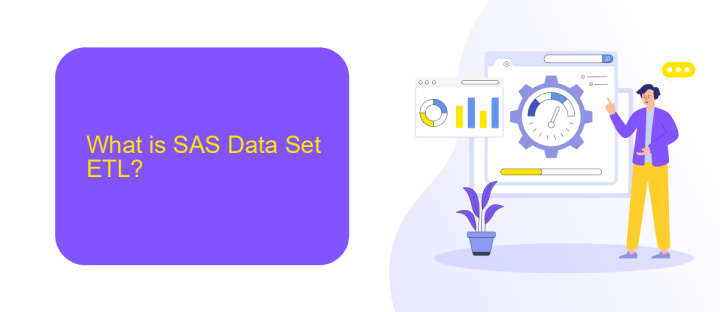SAS Data Sets ETL
Extract, Transform, Load (ETL) processes are essential for managing and analyzing large datasets in today's data-driven world. SAS Data Sets offer a robust framework for performing ETL tasks efficiently. This article explores the key components, best practices, and advanced techniques for leveraging SAS Data Sets in ETL processes to ensure data accuracy, consistency, and reliability.
Introduction
Extract, Transform, Load (ETL) processes are critical in managing and utilizing SAS Data Sets for data-driven decision-making. ETL facilitates the seamless movement of data from various sources into a centralized repository, ensuring data consistency and reliability. This process is essential for organizations aiming to leverage their data assets effectively.
- Extract: Retrieving data from diverse sources.
- Transform: Converting data into a suitable format.
- Load: Importing transformed data into a target database.
Utilizing tools like ApiX-Drive can significantly streamline the ETL process by automating data integrations and transformations. ApiX-Drive offers a user-friendly interface and robust features to connect various data sources effortlessly, ensuring that the ETL process is both efficient and reliable. This integration capability is crucial for maintaining data integrity and supporting data analytics initiatives.
What is SAS Data Set ETL?

SAS Data Set ETL (Extract, Transform, Load) is a process used to collect data from various sources, transform it into a suitable format, and load it into SAS data sets for analysis. This process is crucial for preparing data for statistical analysis, reporting, and data mining. ETL in SAS involves extracting data from databases, flat files, or other data sources, transforming it through data cleaning, aggregation, and other methods, and finally loading it into SAS data sets for further use.
Effective ETL processes in SAS ensure data accuracy, consistency, and reliability. Tools like ApiX-Drive can facilitate the integration of various data sources, automating the extraction and loading phases. ApiX-Drive provides a user-friendly interface to set up data integration without extensive coding, making it easier to handle complex ETL tasks. This integration capability allows organizations to streamline their data workflows, ensuring that the data is always up-to-date and ready for analysis in SAS.
Benefits of SAS Data Set ETL

SAS Data Set ETL offers a range of benefits that significantly enhance data management and processing efficiency. By leveraging SAS Data Sets for ETL processes, organizations can streamline data integration, transformation, and loading tasks, ensuring high-quality data is readily available for analysis and reporting.
- Efficiency: SAS Data Sets provide optimized data storage and retrieval, reducing processing time and resource consumption.
- Scalability: SAS Data Sets can handle large volumes of data, making them suitable for both small-scale and enterprise-level ETL operations.
- Data Quality: Built-in validation and transformation tools ensure data integrity and consistency throughout the ETL process.
- Integration: With services like ApiX-Drive, integrating SAS Data Sets with other platforms and applications becomes seamless, enhancing data accessibility and usability.
- Flexibility: SAS Data Sets support various data formats and sources, allowing for versatile and adaptable ETL workflows.
Incorporating SAS Data Sets into ETL processes not only improves data management but also supports better decision-making through reliable and timely data insights. The combination of robust features and integration capabilities makes SAS Data Sets a valuable asset for any organization looking to optimize its data operations.
SAS Data Set ETL Process

Extract, Transform, Load (ETL) is a crucial process in managing SAS Data Sets. It involves extracting data from various sources, transforming it into a suitable format, and loading it into SAS Data Sets for analysis. This process ensures that data is clean, consistent, and ready for use in analytical tasks.
To start with, data extraction is performed from different sources such as databases, flat files, or web services. The extracted data often comes in various formats and structures, necessitating a transformation phase. During transformation, data is cleaned, normalized, and converted into a format that aligns with the requirements of the SAS Data Set.
- Data Extraction: Gather data from multiple sources.
- Data Transformation: Clean and normalize the data.
- Data Loading: Import the transformed data into SAS Data Sets.
Tools like ApiX-Drive can simplify the integration process by automating data extraction from various sources and ensuring seamless data flow into SAS Data Sets. Utilizing such services can significantly reduce manual effort and increase the efficiency of the ETL process.
Conclusion
In conclusion, the process of ETL (Extract, Transform, Load) for SAS Data Sets is a crucial aspect of data management and analysis. Efficient ETL processes ensure that data is accurately extracted from various sources, transformed into a suitable format, and loaded into SAS Data Sets for further analysis. This not only enhances data quality but also optimizes the overall workflow, making it easier for analysts to derive meaningful insights from the data.
To streamline ETL processes, leveraging integration services like ApiX-Drive can be highly beneficial. ApiX-Drive offers robust solutions for automating data integration between different platforms, reducing manual effort and minimizing errors. By utilizing such services, organizations can achieve seamless data flow, ensuring that their SAS Data Sets are consistently updated and ready for analysis. Ultimately, incorporating advanced ETL tools and services into your data management strategy can lead to more efficient operations and better-informed decision-making.
FAQ
What is SAS Data Sets ETL?
How can I automate the ETL process for SAS Data Sets?
What are the common steps involved in transforming data for SAS Data Sets?
How can I handle errors during the ETL process for SAS Data Sets?
Can I integrate SAS Data Sets with other data sources?
Time is the most valuable resource in today's business realities. By eliminating the routine from work processes, you will get more opportunities to implement the most daring plans and ideas. Choose – you can continue to waste time, money and nerves on inefficient solutions, or you can use ApiX-Drive, automating work processes and achieving results with minimal investment of money, effort and human resources.

